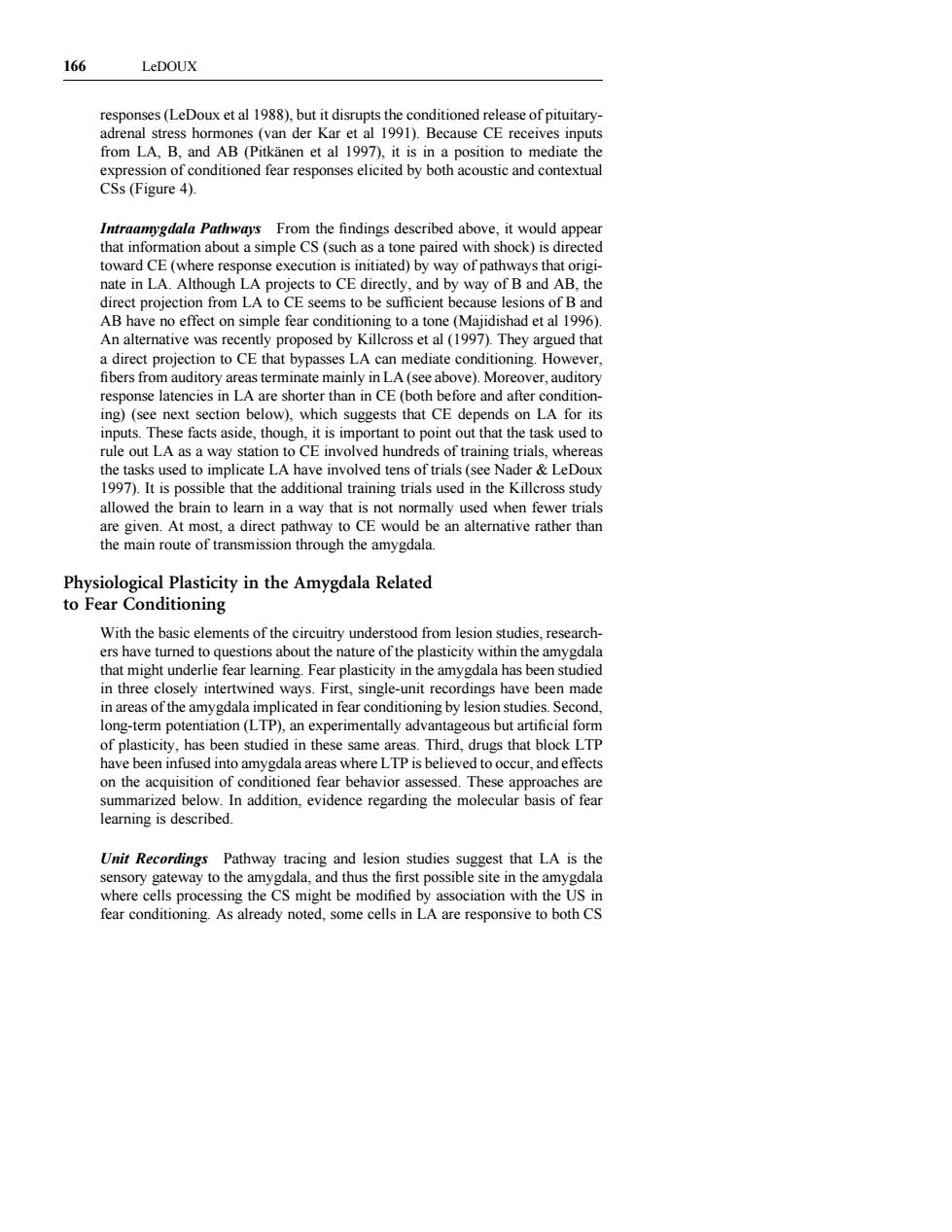正在加载图片...

166 LeDOUX responses(LeDoux etal 1988).but it disrupts the conditioned release of pituitary o hormones(van der kar iput CSs (Figure 4). Intraamygdala Pathways From the findings described above,it would appear that infe nation about a simple CS(such as a tone paired with nock)is directe and hy way of B and AB the direct projection from LA to CE seems to be sufficient because lesions of Band AB ha ve r ing to a tone (Ma shad et al propose fibers from auditory areas terminate mainly in LA(see above).Moreover.auditor response latencies in LA are shorter than in CE(both before and after condition- ng)(se ee next sectio suggests that CE depend on LA for rule out LA as a way station to CE involved hundreds of training trials.whe ea the tasks used to implicate LA have involved tens of trials(see Nader&LeDou 997).It is possible that the additional training trials used in the Killcross study 0 mna way that is the main route of transm ssion through the amvodala Physiological Plasticity in the Amygdala Related to Fear Conditioning With the basicelements of the circuitry under studie that might underlie fear learning.Fear plasticity in the amygdala has been studied in three closely intertwined ways.First,single-unit recordings have been made n areas ofth cated in fear co itioning by les stud has heen studied in th that bleck I Tp have been infused into amygdala areas where LTP is believed tooccurand effects immauson of condned ear benavior asseske molec Unir Recordings Pathway tracing and lesion studies suggest that LA is the sensory gateway to the amygdala,and thus the first possible site in the amygdala CS might be me ning ing the166 LeDOUX responses (LeDoux et al 1988), but it disrupts the conditioned release of pituitaryadrenal stress hormones (van der Kar et al 1991). Because CE receives inputs from LA, B, and AB (Pitka¨nen et al 1997), it is in a position to mediate the expression of conditioned fear responses elicited by both acoustic and contextual CSs (Figure 4). Intraamygdala Pathways From the findings described above, it would appear that information about a simple CS (such as a tone paired with shock) is directed toward CE (where response execution is initiated) by way of pathways that originate in LA. Although LA projects to CE directly, and by way of B and AB, the direct projection from LA to CE seems to be sufficient because lesions of B and AB have no effect on simple fear conditioning to a tone (Majidishad et al 1996). An alternative was recently proposed by Killcross et al (1997). They argued that a direct projection to CE that bypasses LA can mediate conditioning. However, fibers from auditory areas terminate mainly in LA (see above). Moreover, auditory response latencies in LA are shorter than in CE (both before and after conditioning) (see next section below), which suggests that CE depends on LA for its inputs. These facts aside, though, it is important to point out that the task used to rule out LA as a way station to CE involved hundreds of training trials, whereas the tasks used to implicate LA have involved tens of trials (see Nader & LeDoux 1997). It is possible that the additional training trials used in the Killcross study allowed the brain to learn in a way that is not normally used when fewer trials are given. At most, a direct pathway to CE would be an alternative rather than the main route of transmission through the amygdala. Physiological Plasticity in the Amygdala Related to Fear Conditioning With the basic elements of the circuitry understood from lesion studies, researchers have turned to questions about the nature of the plasticity within the amygdala that might underlie fear learning. Fear plasticity in the amygdala has been studied in three closely intertwined ways. First, single-unit recordings have been made in areas of the amygdala implicated in fear conditioning by lesion studies. Second, long-term potentiation (LTP), an experimentally advantageous but artificial form of plasticity, has been studied in these same areas. Third, drugs that block LTP have been infused into amygdala areas where LTP is believed to occur, and effects on the acquisition of conditioned fear behavior assessed. These approaches are summarized below. In addition, evidence regarding the molecular basis of fear learning is described. Unit Recordings Pathway tracing and lesion studies suggest that LA is the sensory gateway to the amygdala, and thus the first possible site in the amygdala where cells processing the CS might be modified by association with the US in fear conditioning. As already noted, some cells in LA are responsive to both CS